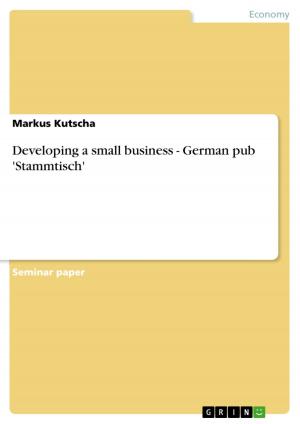| Author: | Beat Flury | ISBN: | 9783638162609 |
| Publisher: | GRIN Publishing | Publication: | January 9, 2003 |
| Imprint: | GRIN Publishing | Language: | English |
| Author: | Beat Flury |
| ISBN: | 9783638162609 |
| Publisher: | GRIN Publishing |
| Publication: | January 9, 2003 |
| Imprint: | GRIN Publishing |
| Language: | English |
Seminar paper from the year 2002 in the subject Economics - Case Scenarios, grade: H7 (Fin), University of Kuopio (Department of Business and Management), course: Competitve Strategy Competitive Advantage, 11 entries in the bibliography, language: English, abstract: Switzerland has been a poor nation as late as the nineteenth century. Its major exports were mercenaries and emigrating citizens (Porter 1998, 307). In the early decades of the 20th century, Switzerland has emerged as an industrial nation of importance. Because Switzerland avoided destruction during World War II the country was an early winner. The circumstances made them well positioned to prosper in early post war periods. By the 1960's, using some measures, Swiss per capita income was the highest in the world (Porter 1998, 307). Industrial success was enough to more than employ all available Swiss citizens at high wages. Total unemployment was in the 60ies 0.0% (Porter 1998, 281) Swiss companies like Nestlé, Novartis, UBS, Roche, Schindler, Swatch Group or Lindt and Sprüngli, are global operating. The leading Swiss multinationals employ far more people outside the country than in Switzerland (Porter 1998, 307). Switzerland is an example how a small nation without a large home market can be a successful global competitor. At the moment Switzerland is still a prosperous country but it lost economic wealth. During the 1990ies Switzerland had the lowest growth rates compared to all OECD member states. This working paper tries to answer the question if Switzerland lost competitive advantage, and if the low growth rates are a result out of this. In the first part of the text Porters theory of national advantage is explained the second part reflects the state of the Swiss economy in the late 1980ies and the third part analyzes what has happened in Switzerland from 1990 to 2000.
Seminar paper from the year 2002 in the subject Economics - Case Scenarios, grade: H7 (Fin), University of Kuopio (Department of Business and Management), course: Competitve Strategy Competitive Advantage, 11 entries in the bibliography, language: English, abstract: Switzerland has been a poor nation as late as the nineteenth century. Its major exports were mercenaries and emigrating citizens (Porter 1998, 307). In the early decades of the 20th century, Switzerland has emerged as an industrial nation of importance. Because Switzerland avoided destruction during World War II the country was an early winner. The circumstances made them well positioned to prosper in early post war periods. By the 1960's, using some measures, Swiss per capita income was the highest in the world (Porter 1998, 307). Industrial success was enough to more than employ all available Swiss citizens at high wages. Total unemployment was in the 60ies 0.0% (Porter 1998, 281) Swiss companies like Nestlé, Novartis, UBS, Roche, Schindler, Swatch Group or Lindt and Sprüngli, are global operating. The leading Swiss multinationals employ far more people outside the country than in Switzerland (Porter 1998, 307). Switzerland is an example how a small nation without a large home market can be a successful global competitor. At the moment Switzerland is still a prosperous country but it lost economic wealth. During the 1990ies Switzerland had the lowest growth rates compared to all OECD member states. This working paper tries to answer the question if Switzerland lost competitive advantage, and if the low growth rates are a result out of this. In the first part of the text Porters theory of national advantage is explained the second part reflects the state of the Swiss economy in the late 1980ies and the third part analyzes what has happened in Switzerland from 1990 to 2000.















